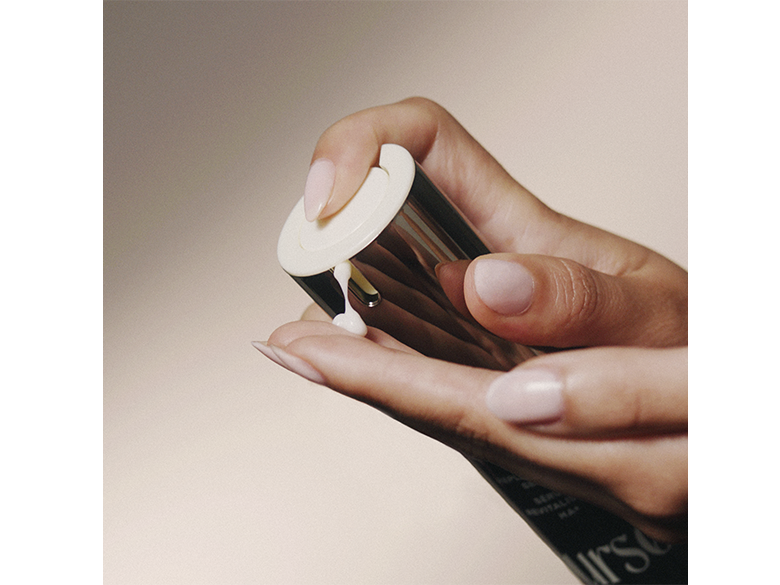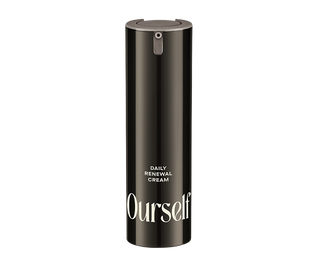
Follow our guide to brighter, glowing, glassy skin:
What Is Skin Brightening?
Skin brightening aims to improve the radiance of the skin. We all want radiant, effortless skin, but many people struggle with dullness and uneven skin tone.
If you’re looking for a powerful method for brightening your skin, try Ourself’s Brightening Peel. This glycolic acid chemical treatment reveals a glowy, even skin tone. If you’re looking for an overall brightening regimen, our All Over Brightening Regimen can provide daily full-face radiance.
Why Do People Have Dull Skin?
Dull skin can result from a variety of different factors. Often, when people register a lackluster complexion in the mirror, they’re seeing dead skin cells collecting on the epidermis, which is the outermost layer of the skin.
Our skin naturally sheds dead skin cells—in fact, our skin’s outer layer renews itself about once a month. However, genetic and environmental factors can cause the skin to lose its glow when dead skin cells remain on the surface and don’t slough off as quickly.
One of the most common sources of dull skin is dehydration. Depending on your climate or the current season, you might notice more dullness in your skin.
Some people also notice that certain foods can trigger dull, uneven complexions, such as spicy foods, high-sugar foods, dairy, and highly processed foods. Even dehydrating alcohol and tobacco use can cause the skin to appear less bright and glowy.
While some people have immediate triggers for dull skin like dehydration or certain foods, others notice dull skin and fine lines begin as they age. Sometimes this is due to sun exposure and sun damage, but other times it is simply genetics and hormones that affect our skin. No matter the cause, you can use several techniques to brighten your skin.
How Are Skin Brightening and Skin Lightening Different?
Skin brightening is not the same thing as skin lightening or whitening. Skin lightening is also known as skin bleaching. This technique aims to alter the pigment or melanin content of the skin for it to become lighter. Often, people use skin-lightening products to treat things like dark spots, melasma, age spots, or birthmarks.
Skin brightening does not alter the pigmentation of the skin but rather exfoliates the skin to slough off dead skin cells and enhance that glow factor. Sometimes, skin brightening products can also help with uneven skin tone and hyperpigmentation.
Ourself’s Brightening Peel can address both uneven skin tone all over the face and hyperpigmentation. Knowing the difference between skin lightening and skin brightening is important to ensure you choose the correct products for your needs.
Are There Any Negative Side Effects of Skin Brightening?
For some, skin brightening products can trigger people with a sensitive skin type. Mild side effects like tingling or redness are to be expected with intensive brightening treatments like chemical peels or laser treatments. However, if you experience intense stinging, itching, or burning, consult a dermatologist.
Skin brightening also often leaves skin more vulnerable to sun damage and the effects of UV rays. When using a brightening regimen, ensure that you incorporate sunscreen and SPF protection wherever you use brightening products, like our Mineral Sunscreen.
How Can You Brighten Your Skin?
Since people often attribute their skin dullness to dehydration, you should also incorporate a moisturizer into your skincare routine to ensure your skin stays supple and smooth. Try out either of our Daily Renewal Creams with hyaluronic acid and Firming Intides™ to enhance the effects of your skin brightening regimen and prevent future dullness. Make sure you use products that benefit your skin type, whether you have dry skin or oily skin.
Physical Exfoliation
Physical exfoliation refers to manual methods by which people can remove the dead skin cells from the epidermis. Many people choose to use physical scrubs on their face and body, as well as body brushes or electronic facial scrubbers.
However, while physical exfoliation can feel nice, some people find the skin on their faces too sensitive for physical exfoliants. If you notice flaky, dull skin on your body, try dry brushing or use a sugar scrub to remove dead skin cells.
Chemical Exfoliation
Chemical exfoliation does not use physically gritty ingredients to scrub away dead skin cells from the outer layer of the skin, but rather mild chemicals with targeted ingredients such as retinol or alpha hydroxy acids to help exfoliate the skin.
Our Brightening Peel is a prime example of a chemical exfoliant peel. We use 34% glycolic acid for a strong treatment that won’t damage the skin. We also include tranexamic acid to reduce redness and target hyperpigmentation in conjunction with the antioxidant phytic acid and vitamin c.
Sometimes, people might prefer a chemical exfoliant over a physical exfoliant because chemical formulas have specifically formulated concentrations. Some people might scrub too hard with a physical exfoliant and irritate the skin. Many skin care products like cleansers, toners, face masks, and body lotions might include chemical exfoliants.
Laser Resurfacing & Microdermabrasion
Professional dermatological procedures like laser resurfacing and microdermabrasion can also have skin brightening effects. With laser resurfacing, thermal energy causes laser beams to penetrate the skin, stimulating collagen production and cell regeneration.
Microdermabrasion is another professional skincare treatment that can improve skin brightness and target discoloration. This procedure thickens your skin’s collagen and simultaneously removes damage from the outer layer of the skin. You might experience redness, peeling, and dry skin from both of these procedures in the days following treatment.
Which Ingredients Brighten Skin?
When you’re researching skincare products like brightening serums, eye creams that target dark circles, and peels, you might wonder which ingredients actually contribute to skin brightness. Keep reading to learn about a few of our favorite skin brighteners in our Brightening Serum.
Glycolic Acid
We use a potent concentration of glycolic acid, which is an alpha hydroxy acid, or AHA, that is found in sugarcane and fruits. Other types of AHA include lactic acid, citric acid, and malic acid. Glycolic acid can penetrate into the skin because it has the smallest molecular structure of all AHA acids.
Like salicylic acid, glycolic can also treat blemishes and breakouts. It has exfoliating and antibacterial properties, which help dissolve the outermost layer of dead skin cells and inhibit bacterial growth.
Additionally, glycolic acid is a humectant, which means that it brings hydration to the cells in your skin. This keeps your skin feeling hydrated, which in turn makes skin appear brighter and more supple.
Tranexamic Acid
We also include tranexamic acid, or TXA, in our Brightening Peel. This acid can reduce redness in the skin while teaming up with glycolic acid to reduce hyperpigmentation and even out the skin tone.
Phytic Acid
Phytic acid is an antioxidant that can also reduce the appearance of redness in the skin, especially when coupled with TXA. This way, you can boost your brightening and hyperpigmentation treatments without redness or blotchiness.
Vitamin C
Vitamin c is another antioxidant that brightens the skin. We bond our vitamin c to a particle of gold and utlilize an effective delivery method to bring brightening benefits to your skin in a stable way.
Conclusion
Skin brightening is a skincare technique to target dullness or a lack of radiance in the skin. For a one-stop regimen to achieve brighter, glowing skin, try out our All Over Brightening Regimen. This set includes our best sellers: a Brightening Peel for in-home targeted treatment, Mineral Sunscreen to protect your freshly-brightened skin from sun damage, and Daily Renewal Cream for hydrating your skin to prevent future dullness.
Sources:
Skin lightening - Cosmetic procedures | NHS
Epidermis and Its Renewal by Stem Cells - Molecular Biology of the Cell | NCBI Bookshelf

